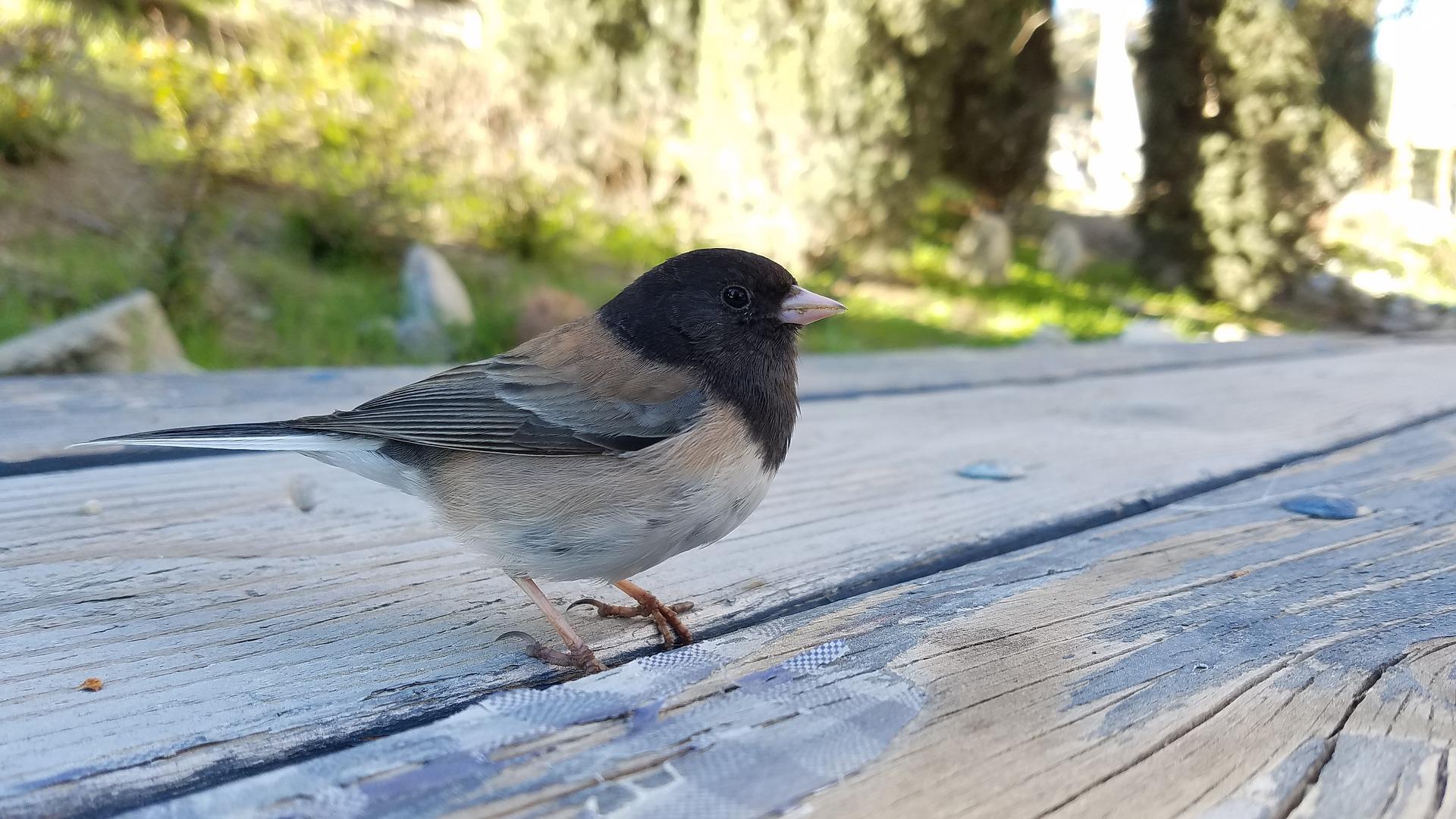Did you spot a black bird with a white belly? But you couldn’t figure out which bird species it was? Then you have come to the right place!
Read on till the end to learn about the top 9 examples of black birds with white bellies. And I will also share the pictures of each of them to help you identify them easily.
#1. Dark-eyed Junco
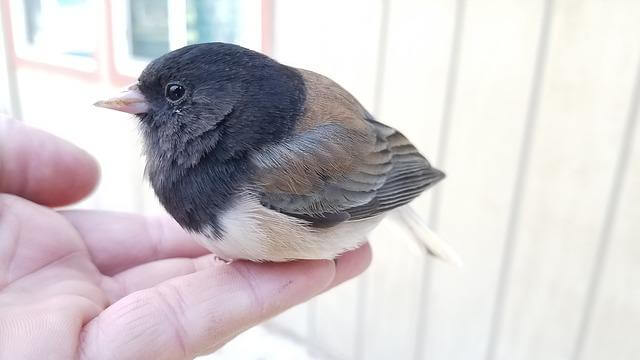
Size & Body Structure: A Dark-eyed Junco is a medium-sized sparrow with a rounded, short bill and a long tail. In terms of size, it is just a bit bigger than a Chipping Sparrow.
How Do They Behave? Typically, you will find these birds hopping around the bases of trees and shrubs or on the lawns looking for fallen seeds. On grounds, they usually hop forward but can also do so sideways while circling insect prey.
Color: There exists a huge range of geographical difference in the Dark-eyed Junco bird species. However, in general, there are two widespread forms of these birds.
- The Eastern United States And Most Of Canada: Slate-colored Junco is found that has smooth gray at the top.
- Much Of The Western United States: Oregon Junco is found that has a dark hood and warm brown back.
Despite the variations, the Dark-eyed Junco birds are dark-gray or brown-colored birds with white outer tail feathers.
Where Can You Find Them? The Dark-eyed Juncos are one of North America’s most common perching birds. They are usually found breeding in forests across the Western US, Canada, and the Appalachians. In the winter, you can find these birds in fields, parks, roadside, and even in your backyards.
#2. Black Capped Chickadee
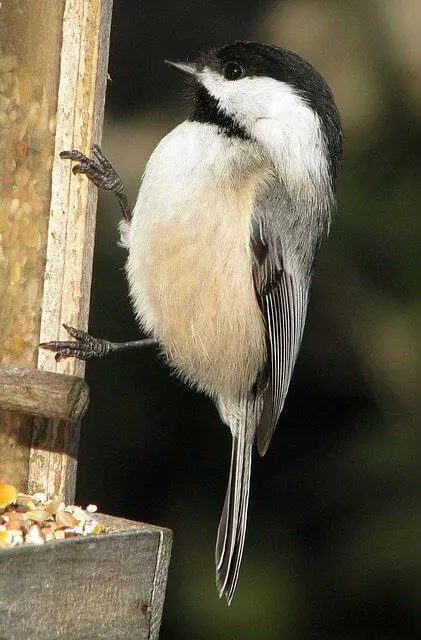
Size & Body Structure: Black Capped Chickadees are tiny birds having large heads but short necks. Their relative size can be assumed to be smaller than sparrows. They have a spherical body shape, long-narrow tail, and short bill.
How Do They Behave? While foraging, these birds hop on trees or on the ground. Their flight pattern is slightly undulating with quick wing beats.
They often tend to fly in open areas and roads with a bouncy flight. These cute birds are known to bathe in standing water, snow, and even in dew. However, they mainly roost in cavities or thick vegetation, especially when the night is quite cold.
Color: Follow this table to learn about the Black Capped Chickadee’s color:
| Body Parts: | Color: |
| Cap | Black |
| Cheeks | White |
| Back | Soft Gray |
| Eyes | Black |
| Wing Feathers | Gray Edged With White |
Where Can You Find Them? Black Capped Chickadee is one of North America’s most familiar and widespread birds. You can find this bird in any habitat that has woody shrubs or trees, forests, residential neighborhoods, parks, you may name it.
#3. Black-Billed Magpie

Size & Body Structure: These are long-tailed and heavy-billed birds. In terms of size, these birds are typically smaller than a raven but larger than a jay.
How Do They Behave? These are social and curious birds that tend to come in large flocks. Generally, on the ground, they are found to be walking. They tend to move in groups and make different calls.
Color: Black-billed Magpies are another bird that you might see as the blackbird with white bellies. These birds usually appear entirely black and white. But when you view them in good lighting conditions, their wings and tails can shine with a blue-green iridescence.
| Body Parts: | Color: |
| Overall Body | Black & White |
| Upperpart | Mostly Black |
| Outer Wing | Has A White Patch |
| Back | Has Two White Stripes |
| Wing & Tail | Blue-Green Iridescent Flashes |
Where Can You Find Them? Black Billed Magpies are the birds of Western North America, and you can find them in fields, towns, and the stream corridors of the West. They prefer open areas and are not likely to be found in dense woods.
#4. Downy Woodpecker
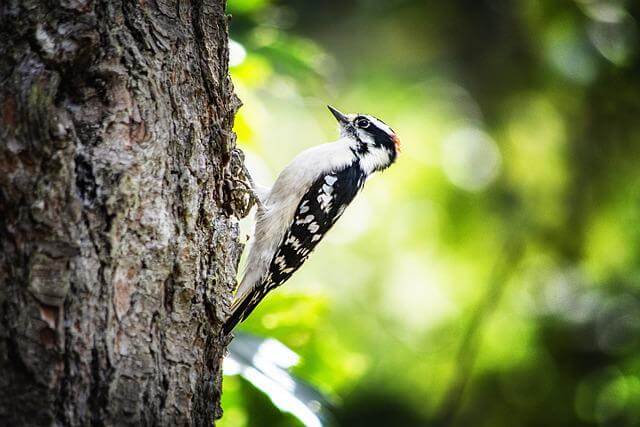
Size & Body Structure: These are small birds with a short beak. You can consider them the small version of the classic woodpecker body structure.
These birds have a straight chisel-like beak and wide shoulders. Interestingly, the Downy Woodpecker’s beaks look smaller for the bird’s size compared to other woodpeckers.
How Do They Behave? The diet of these birds mainly includes insects. They forage on minor branches, twigs, trunks, and major limbs of trees. They have a distinctive rising and falling flight style. They tend to make a lot of noise (by their calls and drumming on trees) in the spring and summer.
Color: Overall, looking at these birds, you will get a checkered black and white impression.
The black upper parts of these birds are checked with white color on wings. The Head is boldly striped, and the back has a broad white stripe down the center. The males tend to have a small red patch on the back of the head.
Where Can You Find Them? These birds are the smallest woodpeckers in North America, quite common and widespread.
They are native to the forested areas, specifically the deciduous of North America. Their range includes most of the US and Canada except the deserts of the southwest and tundra of the North.
You can find these birds in open woodlands and specifically among deciduous trees. However, they are found in various habitats, including forests, woodlots, river groves, orchards, and shade trees.
#5. Rose Breasted Grosbeak
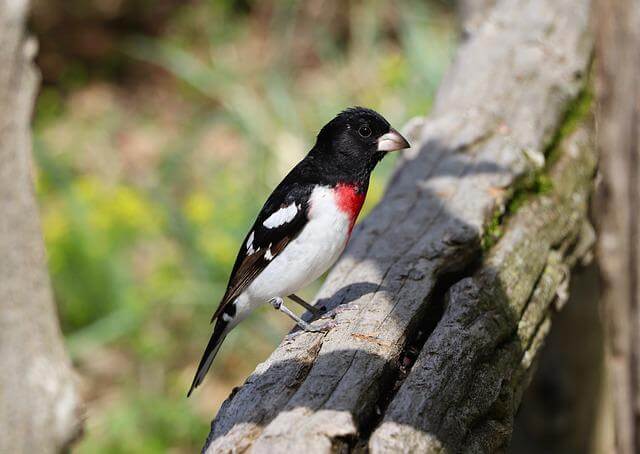
Size & Body Structure: These are medium-sized birds with large triangle-shaped beaks. While comparing the size, they can be considered bigger than a house finch but smaller than an American Robin.
How Do They Behave? These are migratory birds that tend to hop on the ground and have an undulating flight pattern. You will also find them often visiting your backyard bird feeders. Another interesting to note is they become when startled.
Color: In the case of the Rose-Breasted Grosbeak, the males and the female bird have different colors.
| Bird Type: | Color |
| Adult Male Birds | Black & White, With Red Chevron from Throat To Middle Of The Breast |
| Females & Immature Birds | Brown & Heavily Streaked. Also, a bold Whitish Stripe Exists over the Eyes |
Where Can You Find Them? These birds are typically found across Eastern North America. They are commonly found in forest edges, regenerating woodlands, and parks. Also, don’t be surprised to see these birds on the fruiting trees, which they likely do to fuel up their flights during the migration.
#6. Blackpoll Warbler

Size & Body Structure: The Blackpoll Warbler is a cute little songbird with a small thin beak and a short tail. Compared to other warblers, they typically have larger wings.
How Do They Behave? These birds pick insects from the foliage, but they are also found to be foraging near the trunks of evergreen trees. They creep along the branches of tall trees to get insects from leaves, barks, and twigs. During spring migration, these birds sing while looking for food.
Color: The color pattern of the Blackpoll Warbler is highlighted in the table below:
| Bird Type: | Color: |
| Breeding Male | Black & White, with Black Cap, Cheeks-White bordered by Black Moustache |
| Breeding Female | Streaky Black, White, and Gray but lack black cap like males and white cheeks. |
Both genders of these birds have orange-yellow legs and two white wingbars.
Interestingly, these bird species molts in a different plumage in the late summer when the body part becomes greenish-yellow from above and dark streaking down the back.
Where Can You Find Them? These birds breed in the forest of northern North America and are considered common migrant thorough much of North America. They usually stop in deciduous and evergreen forests during migration.
#7. Black Phoebe
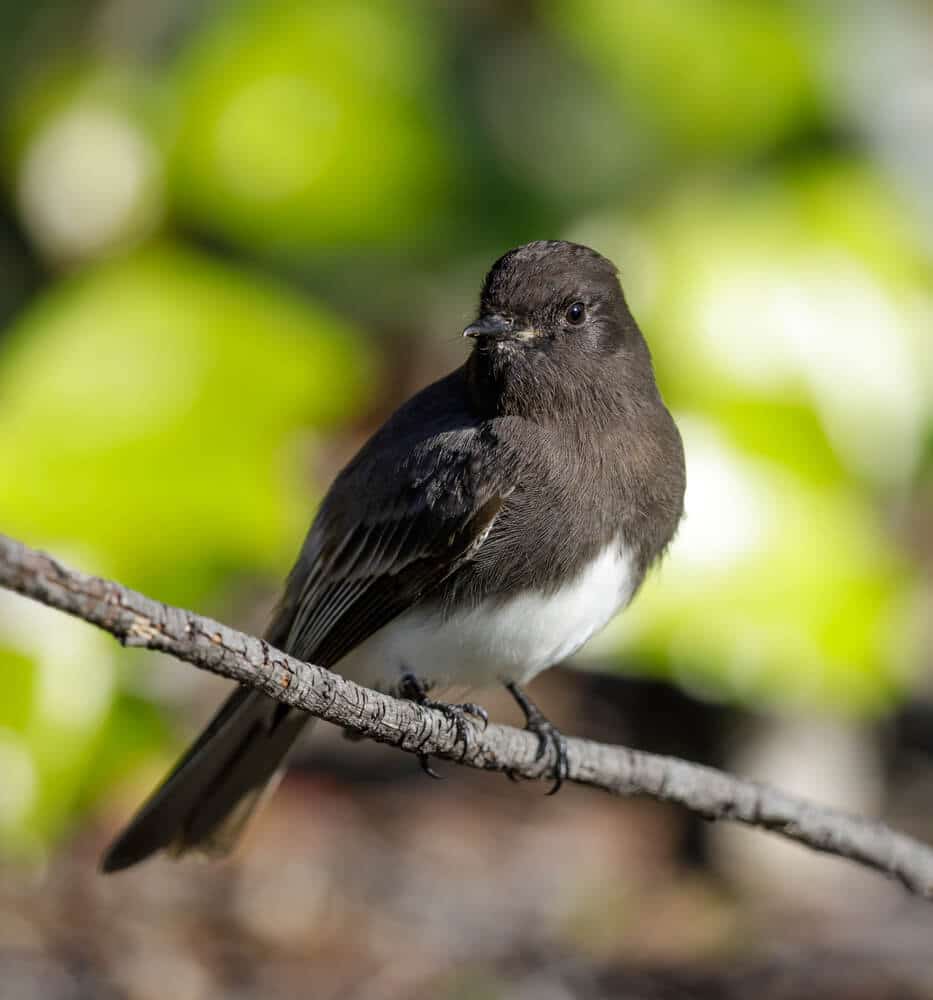
Size & Body Structure: Black Phoebes are small, plump song birds. In terms of size, you can consider them smaller than a Western Scrub Jay but larger than an American Goldfinch.
At the rear part of the crown (in case you don’t know, crown = top of the head) you can often notice a slight peak.
How Do They Behave? These birds generally sit upright on low perches near the water surfaces. However, they take brief flights to catch insects. And when they perch, you can notice them constantly pumping their tails up and down.
Color: Follow the below table to learn about the color of the different body parts of Black Phoebes:
| Body Parts: | Color: |
| Chest & Upperparts | Mostly Sooty Gray |
| Head | Slightly Darker, Black |
| Belly | Clean White |
| Wing Feathers | Edged with Pale Gray |
Where Can You Find Them? In the US, in most cases, you can find these black phoebes near water. You can find them around lakes, streams, rivers, and even around cattle tanks. These birds nest in mud cups that are anchored in protected nooks.
As long as there is any water source present and some ledge to anchor the mud nest, you can guess that the black phoebes are not very far.
#8. Eastern Towhee

Size & Body Structure: Eastern Towhee is a large sparrow with a long tail and thick beak. It is smaller than a Robin but bigger and heavier than a song sparrow.
How Do They Behave? They are ground-feeding birds. Usually, it is difficult to spot these birds as they tend to be shy and like heavy ground cover. However, you are more likely to find these birds when they climb into shrubs and low trees for singing.
Color: The color pattern of these birds is summarized in the following table:
| Bird: | Color: |
| Male | Bold sooty black above and breast, warm rufous sides, and white on the belly |
| Female | Follow the same pattern; the only difference is they are rich brown where males are black |
Where Can You Find Them? Eastern Towhee rangesr sea level to 6500 ft. along the borders of Tennessee and North Carolina in the summer. These birds are found everywhere in the southeastern regions of Canada and southeastern areas of the US.
#9. Tree Swallow
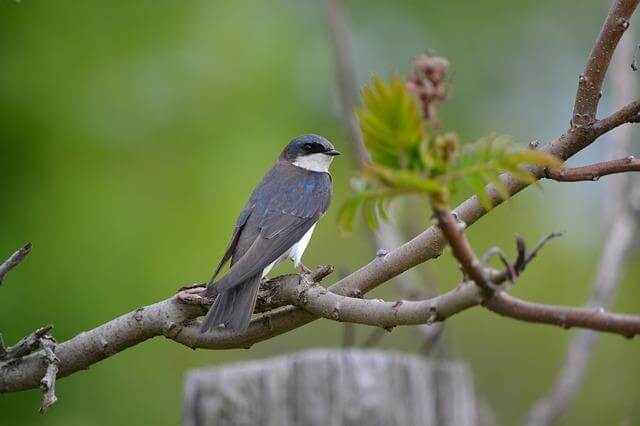
Size & Body Structure: These are small songbirds with long pointed wings and tiny beaks. The shape of their beak is quite short and flat. In terms of size, they are larger than a Bank Swallow but smaller than a Purple Martin.
How Do They Behave? These birds mainly forage in flight and they may pick items from the water surface while flying. Also, they perch on bushes to eat berries. However, at times, you can also find them feeding on the ground, especially in cold weather.
Color: In the case of Tree Swallow, the adult males typically have blue-green color in the above part while white color underneath. And they also have blackish flight feathers.
The Females tend to be dull colored with more brown in the upper part of the body. However, the Juveniles are entirely brown on the above.
Where Can You Find Them? These birds breed in North America. You can find these birds as far as south as Tennessee, New Mexico, and California in the west, and Kansas in the center. These birds prefer breeding in open habitats like wetlands and fields.
They tend to nest in tree cavities and artificial nest boxes. You can often find the foraging flocks of these birds over wetlands and agricultural fields.
Final Thoughts
So, what is the black bird with a white belly? If you saw a small black bird with a white belly hopping on ground, it is likely a Dark-eyed Junco. However, it can also be birds like the Black-Capped Chickadee, Black-Billed Magpie, Rose-Breasted Grosbeak, or others based on the bird’s body, color, behavior, and habitat.
While identifying any bird, the body structure of the bird, overall color pattern, behavior, and habitat are some of the essential factors to be taken into account.
I already shared all those factors and gave you an overview of them for each bird. So I hope now you can find out the bird. Best of Luck and Happy Birding!
Sources:
- allaboutbirds.org
- birdsoftheworld.org
- audubon.org
- wikipedia.org

